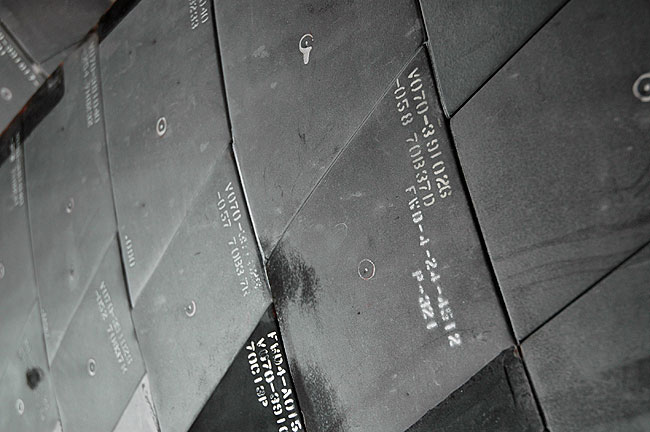NASA Offers Space Shuttle Tiles To Schools

NASA is holding a "baked-goods" sale for schools, but instead of tasty desserts, the space agency is offering something much hotter: space shuttle heat shield tiles.
NASA began Wednesday offering 7,000 of the black-and-white lightweight tiles to U.S. schools and universities that "want to share technology and a piece of space history with their students," according to a space agency statement.
The tiles are free for the asking, but following the "transfer protocol" for government property, schools must cover the shipping and handling charge – a grand total of $23.40.
That's quite the bargain considering that NASA estimates its original acquisition cost was $1,000 per tile.
According to the tiles' manufacturer, Lockheed Martin, the baked silica squares originally cost NASA about $10,000 per square foot installed. Typically, tiles measure about a quarter of that, or 6 by 6 inches (15.2 by 15.2 cm). [INFOGRAPHIC: NASA's Space Shuttle from Top to Bottom]
More than 20,000 tiles are installed on each space shuttle and each tile is designed to survive 100 trips to space and back. Varying in thickness from one inch (2.54 cm) to five inches (12.7 cm) depending on the heating they will be subjected to, the tiles collectively protect the orbiter from temperatures as high as 2,300 degrees Fahrenheit during its reentry into the Earth's atmosphere.
The silica tile material – referred to as LI-900 or Lockheed Insulation-9 pounds per cubic foot – insulates heat so well that tiles can be held bare-handed on one side even while the opposite side is still red hot.
Get the Space.com Newsletter
Breaking space news, the latest updates on rocket launches, skywatching events and more!
Educators can demonstrate that ability in the classroom, substituting a blow torch for the re-entry-generated heating.
NASA is fulfilling the requests for the tiles on a first-come, first-served basis. Qualifying educational institutions can apply online through the General Services Administration website at http://gsaxcess.gov/NASAWel.htm.
A part of NASA's ongoing efforts to "preserve the shuttle program's history and inspire the next generation of space explorers, scientists and engineers," according to a release, the heat shield tile offer comes as the space agency is preparing to retire its orbiter fleet next year. Two more shuttle missions are scheduled, with a third pending congressional funding.
The launch of the next flight, Discovery’s STS-133 mission, has been delayed to next year as NASA investigates the cause of cracked support beams on the shuttle’s external tank.
Visit collectSPACE.com for continuing coverage of NASA’s efforts to share artifacts from the space shuttle program.
Copyright 2010 collectSPACE.com. All rights reserved.
Join our Space Forums to keep talking space on the latest missions, night sky and more! And if you have a news tip, correction or comment, let us know at: community@space.com.

Robert Pearlman is a space historian, journalist and the founder and editor of collectSPACE.com, a daily news publication and community devoted to space history with a particular focus on how and where space exploration intersects with pop culture. Pearlman is also a contributing writer for Space.com and co-author of "Space Stations: The Art, Science, and Reality of Working in Space” published by Smithsonian Books in 2018.In 2009, he was inducted into the U.S. Space Camp Hall of Fame in Huntsville, Alabama. In 2021, he was honored by the American Astronautical Society with the Ordway Award for Sustained Excellence in Spaceflight History. In 2023, the National Space Club Florida Committee recognized Pearlman with the Kolcum News and Communications Award for excellence in telling the space story along the Space Coast and throughout the world.










